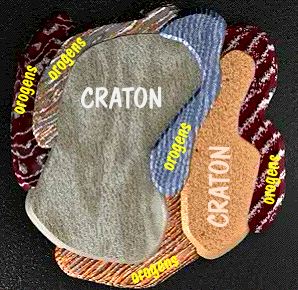
Achieving Isostatic Equilibrium
A craton is a body of rock which has achieved equilibrium. Fundamentally it has avoided deformation for a long period of time and exists in a state where there few tectonic forces that can reach it.
An orogen is a linear body of rock that has been heavily folded and faulted. It has been interpreted as once having been on the border of plate collisions.
Because these orogens have certain sets of features, they can be traced back to the time (potassium -argon dating) and the conditions under which they formed.
1.) Upper marine Clastics
last material formed from the normal ocean filling in.
2.) marine evaporates
earlier material formed as the ocean was shallow and evaporated at about the same rate as fill in.
3.) lower non-marine clastics
First material formed as rift valley separates and sediment washes down from valley walls.
1.) paired metamorphic belts
The burial material in the trench and new high pressure/low temperature metamorphism by the compression of the sediment. (Melange)
This is paired with the regional metamorphism in the crust near the subduction zone.
2.) stratovolcanoes in magmatic arcs.
The remains of eroded volcanoes in an arc.
3.) granitic batholiths in linear belts.
fin ally somewhat linear batholiths which represent the cooled magma reserves of the old volcanic arc.
1.) Formation of intensely folded and thrusted mountain ranges.
these produce much metamorphic activity of all types and have sufficient energy to even cause rock melting hence igneous bodies.
2.) The highest mountain strata is typically marine strata.
It comes form the pushed up sediment along the former coast lines and years of deposition onto the original continental shelves.
3.) The presence of the serpentinites.
Alteration products of highly deformed ocean crust, also caught in the "squeeze".
| NEXT | TOC | PREV |